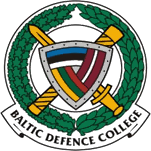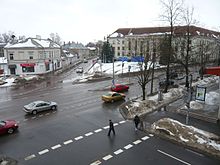The Baltic Defence College (BALTDEFCOL) is a multinational military college, established by the three Baltic states (Estonia, Latvia and Lithuania) in 1999. It serves as a centre of strategic and operational research and provides professional military education to intermediate- and senior-level officers and government officials from the founding states, other member states of the European Union (EU) and the North Atlantic Treaty Organization (NATO) countries, as well as other European countries including Armenia, Azerbaijan, Bosnia and Herzegovina, Georgia, Moldova, Montenegro, Serbia and Ukraine.[1]
 Emblem | |
| Motto | Ad securitatem patriarum (Latin: For the fatherlands’ security) |
|---|---|
| Type | Military college |
| Established | 25 February 1999 |
Academic staff | Approx. 50[citation needed] |
| Students | Approx. 80[citation needed] |
| Location | , 58°22′24″N 26°43′21″E / 58.37333°N 26.72250°E |
| Affiliations | ISMS; IAMP |
| Website | www |
Research
The Baltic Defence College hosts roundtable seminars and major conferences annually, including a Cyber Conference and a Conference on Russian Power Projection.[2] The college's academic faculty also engage in personal research, generating a range of different articles, books and commentaries each year.[3]
Commandants
| Nationality | Rank | Name | Term |
|---|---|---|---|
 Denmark Denmark | Brigadier general | Michael H. Clemmesen | 1999–2004 |
 Lithuania Lithuania | Brigadier general | Algis Vaičeliūnas | 2004–2007 |
 Latvia Latvia | Brigadier general | Gundars Ābols | 2007–2010 |
 Estonia Estonia | Brigadier general | Meelis Kiili | 2010–2012 |
 Lithuania Lithuania | Major general | Vitalijus Vaikšnoras | 2012–2016 |
 Latvia Latvia | Major general | Andis Dilāns | 2016–2020 |
 Estonia Estonia | Brigadier general | Ilmar Tamm | 2020–2023 |
 Lithuania Lithuania | Brigadier general | Alvydas Šiuparis | 2023-present |
Deans

The dean between 2004 and 2008 was Tomas Jermalavicius – a Lithuanian researcher of strategic resiliency.[7]
...
Further reading
- James Corum, Art Johanson: 20th Anniversary History Book (pdf, 15 MB)